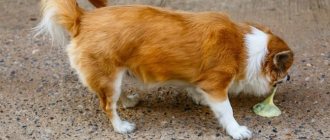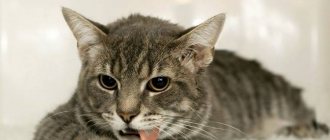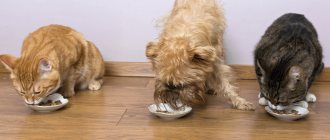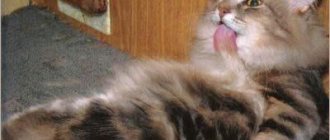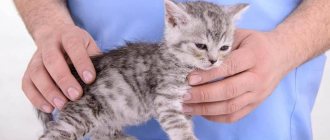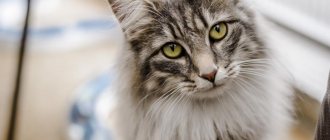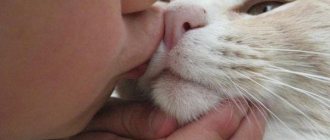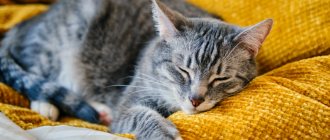When a cat vomits yellow liquid, this means two options: vomiting bile or eating a certain type of food. If a cat eats a specific food, it may vomit yellow color.
It is quite easy to distinguish it from bile: vomit has a gray tint.
In this case, there is no reason to worry; you simply need to exclude this type of food, since the cat’s body does not accept it.
The situation is different with rich yellow vomit - this means that bile has entered the cat’s stomach, which should not be in the cat’s stomach if the body is healthy.
Yellow foam and vomiting - what does it mean?
The gag reflex is a special defense mechanism of the animal, which is a simultaneous contraction of the abdominal muscles and diaphragm. A sharp jump in intra-abdominal pressure provokes the release of gastric contents out through the oral cavity. The cat is vomiting yellow liquid. This may be due to disturbances in the functioning of the pancreas and stomach, pathologies of the gallbladder and its ducts, diseases of the liver and kidneys.
© shutterstock
Types of cat vomit:
- Vomiting foam . A gag reflex with yellow or white foamy liquid may be a sign of a serious illness such as feline distemper or panleukopenia. A distinctive feature of vomit is the absence of additional impurities (wool or food residues) in it. Without timely treatment, these diseases inevitably lead to the death of the pet.
- Cats vomit after eating . If a cat eats quickly and a lot, then its digestive system cannot cope with the volume of incoming food, and it spontaneously ejects from the animal’s mouth. The result is regurgitation of food, saliva, mucus, and white or yellow foam immediately after eating. Dry food can also be a factor that provokes vomiting with foam.
- Diet and vomiting . The cat vomits after a fatty meal - this condition can only be eliminated through a special diet. Nausea and yellow foam can occur in animals on a dry diet; it is important to correctly alternate between natural and store-bought food, and always provide your pet with water.
- Wool vomiting . Wool is a frequent guest in the digestive sections of a cat, as animals constantly lick themselves and swallow saliva. The accumulation of hairballs in the stomach causes obstruction and, as a result, a gag reflex with yellow foam and mucus. Blockage of the gastrointestinal tract may be accompanied by vomiting with foam, bile, blood and food debris. In this case, there is only one treatment - urgent surgery.
- Vomiting due to injury . Damages to the internal organs of an animal are always accompanied by a gag reflex interspersed with blood. If the gallbladder and liver are injured, yellow foam may be released, and if the lungs and bronchi are injured, white foam will be released. A characteristic feature of this situation is the absence of other symptoms associated with the functioning of the animal’s digestive system.
- Parasitic infestations and vomiting . In the first stages, helminth infection is accompanied by the release of white or yellow foam from the cat’s mouth; worms and larvae can also come out through the mouth. If a cat burps yellow liquid, this means that his body is full of helminths and is poisoned by their waste products.
- Vomiting due to disease of the internal organs . Yellow vomit with foam means that the pet has pathologies of the liver and gall bladder. At the same time, the smell of vomit contains the smell of bile. The cat may also have diarrhea with bile and blood.
- Infection and vomiting . Yellow vomit and watery diarrhea are the first signs of infectious diseases in cats. Among them are herpes, calicivirus, rhinotracheitis and others.
- Surgery and vomiting . Complications after surgery in cats may be indicated by yellow vomit with foam, bloody clots and saliva. The release of anesthesia can also occur accompanied by a gag reflex with foam.
- Intestinal obstruction and vomiting . This is a formidable and dangerous symptom, meaning that an obstacle has formed in the cat’s intestines to the natural release of digestive products. Intestinal blockage can be urgently eliminated only by surgical intervention in a clinical setting.
- Cat pregnancy . If a pregnant cat is vomiting yellow liquid, this may indicate that she has gallbladder and duct disease that has worsened due to pregnancy.
© shutterstock
Interesting! In the cat breed, the gag reflex, as an instinct of self-preservation, is much more developed than in other pets - dogs, birds, rodents, and so on. Therefore, cat breeders face this life problem quite often and must be well versed in this topic!
What treatment is prescribed?
The pet must be shown to a specialist if the owner did not help him on his own.
If your cat is vomiting bile and the condition does not improve after first aid, you should urgently take your pet to the doctor. After an initial examination and medical history, the doctor will give a direction for a series of diagnostic procedures that will help find out why the cat is burping. When the diagnosis becomes known, a comprehensive treatment regimen is prescribed aimed at eliminating the original source of the problem.
Sorbents will help remove toxins from the body, and to prevent the cat from vomiting again, antispasmodics and antiemetics are prescribed. During therapy, food intake should be limited; it is better if the cat fasts for a day. It is necessary to ensure that the animal drinks plenty of liquid. Water will help remove toxins from the body faster, making treatment more effective. To prevent dehydration, it is recommended to give the cat a solution of Regidron. If the animal's condition is satisfactory, it can be treated at home, but be constantly in touch with the doctor. When a cat vomits yellow liquid and there are brown, red or black inclusions in it, hospitalization is required.
The cat has yellow vomit - reasons
In most cases, it is bile that turns a cat's vomit yellow. An admixture of bile appears as a bright yellow color and a specific odor; these signs are difficult to confuse with something else. The causes of cat vomiting lie in diseases of the liver and choleretic tract.
A similar gag reflex can occur after eating stale or low-quality food, as the load on the liver increases significantly.
Cats very often vomit from fatty foods, which is also associated with overload of internal organs - the liver and gall bladder. Antibiotics have a depressant effect on the liver and can cause a gag reflex with bile. An overdose of any medication can cause yellow vomit with foam or mucus.
What you should pay attention to when an animal is vomiting:
- circumstances and time of the first vomiting;
- frequency of urges, volume of vomit;
- consistency, composition and amount of vomit per day;
- does the cat still have an appetite?
- Is there any desire left to drink?
- the presence of other symptoms and their nature;
- duration of the gag reflex relative to the first vomiting;
- does your pet have chronic diseases?
- Has the cat been vaccinated and dewormed?
© shutterstock
Green and yellow vomit indicates that a large amount of bile has entered the stomach, and intestinal contents are also present. If your pet eats grass, the vomit will appear green. Yellow vomit with mucus indicates erosive changes in the mucous membranes of different parts of the animal’s digestive system.
Diagnostics
Diagnosis of vomiting with bile may include a whole range of necessary examinations.
Along with a general examination of the animal and taking an anamnesis, the following may be required:
- Blood tests to evaluate liver and pancreas function.
- Ultrasound – to assess the structure of the liver, gallbladder and biliary tract, pancreas, intestines, gastrointestinal motility, and search for tumors.
- X-ray – to exclude foreign objects in the gastrointestinal tract, tumors, gallstones.
- Gastroscopy – examination of the inner surface of the stomach and esophagus using a gastroscope, as well as performing a biopsy for histological analysis of tissue.
Vomiting foam and bile - possible diseases
The cat vomited yellow liquid! Repeated yellow vomiting with impurities of food and foam indicates the presence of an inflammatory process in some part of the animal’s digestive system. The stomach cannot cope with the volume of food entering it, spasms begin with the release of vomit. To make a correct diagnosis, it is better to contact a veterinary clinic, because there are a lot of diseases associated with the digestive system - gastritis, pancreatitis, ulcers, duodenitis, colitis and so on.
Attention! The cat is vomiting white foam, the provoking factor in this case is hunger. After all, white foam is the result of a chemical interaction between protective mucus from the walls of a hungry stomach and oxygen from the surrounding air.
Yellow vomit with foam and blood may occur due to internal bleeding in the animal's intestines, stomach, or esophagus. If there is a tumor or ulcerative formation, bloody streaks will be present in the vomit along with foam. If the shade is scarlet and uniform, this means that blood is secreted in the upper gastrointestinal tract - the pet’s mouth, larynx or esophagus. Bleeding is dangerous and does not go away on its own - you definitely need emergency help from a specialist veterinarian!
Prevention
To prevent vomiting, you must follow the recommendations below:
- Regular vaccination.
- Balanced diet. Food is selected according to age, gender, and physiological state.
- Quarterly deworming.
- Annual visit to the veterinary clinic for a preventive examination.
- Combing. Freeing the cat from excess fur.
- Preventing excessive licking.
- Feeding cat herbs that cleanse the intestines.
- Using quality cat toys.
- Regular cleaning of cat houses and apartments: small items should not be within the cat’s reach.
- Keeping the cat away from the trash can.
- You should not feed your pet before the trip.
Brushing a cat
We invite you to join our Zen channel and group on VKontakte or Odnoklassniki, where new articles for pet owners are published.
Similar articles:
- My cat has a nosebleed - what should I do?
- Inflammation of the lower lip in a cat
- Clear nasal discharge in cats
Possible diseases
Isolated cases of bile vomiting in cats do not require the help of a veterinarian. Most often they occur due to overeating. In this case, it is enough to adjust the pet’s diet.
Repeated attacks with foam and bile indicate the onset of an inflammatory process in the gastrointestinal tract. This could be a stomach ulcer, gastritis, pancreatitis and other diseases. A veterinarian's consultation is required to make a diagnosis.
White vomit is a consequence of prolonged fasting. It occurs due to the reaction of stomach mucus to oxygen. The animal cannot be fed abundantly at once; portions are given frequently and in small quantities.
Yellow vomiting with blood and foam is an alarming symptom. It appears when there is bleeding in the esophagus, intestines or stomach. With an ulcer or tumor, streaks of blood are present in the mass. Scarlet and homogeneous blood appears when the upper gastrointestinal tract is damaged. This condition requires urgent assistance from a veterinarian.
Vomiting hair in cats
Vomiting that shoots out in a strong stream over long distances requires immediate delivery of the cat to the clinic. The symptom occurs when there is intestinal blockage, high intracranial pressure, or brain damage. Doctor's help required.
In kittens, vomiting occurs due to congenital pathologies of the gastrointestinal tract or low-quality mother's milk. The smaller the cub, the less chance of survival. Kittens from two months of age have a better chance of survival.
A fragile body has a high intolerance to drugs.
If vomiting is accompanied by diarrhea, lethargy, loss of appetite, and fever, then this may be a sign of infectious diseases. Urgent consultation with a veterinarian is required.

